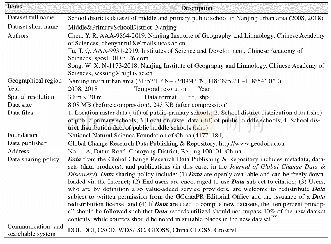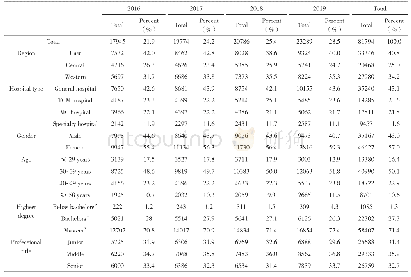《Table 1 Characteristics of public rental housing and its communities》
 提示:宽带有限、当前游客访问压缩模式
提示:宽带有限、当前游客访问压缩模式
本系列图表出处文件名:随高清版一同展现
《"Poverty Decentralization or Reconcentration: An Empirical Study of the Effects of Collected Public Rental Housing in Changzhou, Jiangsu Province"》
Source:Drawn based on the statistic data from Changzhou Housing Authority.
In addition,according to the statistical data and interviews,the poor are mainly divided into four categories.The first is urban retired employees over the age of 60,who once had a set of welfare housing and had to live together with their children and grandchildren due to having many children and their children’s financial incapability to purchase a house.In order to improve the living conditions,they transferred the house to their children,and they applied for public rental housing.The second is the children of urban retired employees in the first category,about 30 to 45 years old,who dropped out of school in their youth age,unmarried,or divorced.Some of them are just released from prison,unskilled or without stable work,relying on relatives and friends for relief and governmental assistance.The third is homeless people,who lost their houses due to serious illnesses,accidents,crimes,and divorce.The fourth is lonely elderly people over 70 years old and disabled people enjoying basic living allowance(see Table 2).It is worth noting that the majority of these four groups of people have long lived in old communities and have no experience of purchasing or renting commercial housing.The collected public rent housing in the old communities only reduces the housing cost of the poor,but it does not effectively improve their living standards.
| 图表编号 | XD0012620200 严禁用于非法目的 |
|---|---|
| 绘制时间 | 2018.06.01 |
| 作者 | Sun Jie、Zhu Xigang、Song Weixuan、Liu Fengbao、Li Min |
| 绘制单位 | School of Architecture and Urban Planning,Nanjing University、Urban Planning Society of China、School of Architecture and Urban Planning, Nanjing University、Nanjing Institute of Geography and Limnology,Chinese Academy of Sciences、School of Architecture and |
| 更多格式 | 高清、无水印(增值服务) |
查看“Table 1 Characteristics of public rental housing and its communities”的人还看了
-

- Table 1 Metadata summary of“School districts dataset of middle and primary public school in Nanjing urban area(2008,2018
-

- Table 1 Demographic characteristics of participating doctors in China’s tertiary public hospitals from 2016 to 2019
-

- Table 1 Demographic characteristics of participating doctors in China’s tertiary public hospitals from 2016 to 2019





